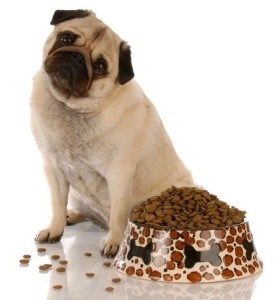How Much Should I Be Feeding My Dog?
 Just like humans, dogs need the right amount of food in order to maintain optimal health. Canines lacking food run the risk of nutritional deficiencies, but dogs eating too much are more likely to become obese and suffer from related health problems. In fact, obesity is like a Pandora’s Box. It can lead to osteoarthritis, congestive heart failure, skin disorders, and even certain cancers.
Just like humans, dogs need the right amount of food in order to maintain optimal health. Canines lacking food run the risk of nutritional deficiencies, but dogs eating too much are more likely to become obese and suffer from related health problems. In fact, obesity is like a Pandora’s Box. It can lead to osteoarthritis, congestive heart failure, skin disorders, and even certain cancers.
There’s no denying that it’s important to determine how much your dog needs to eat each day, but there’s no one simple formula. It depends on the type of food, type of dog, eating schedule, normal amount of exercise, and current medications. Feeding requirements can vary drastically, even between dogs who are the same age, breed, or gender, so don’t feel discouraged if your feeding habits differ from your friend’s or neighbor’s.
Feeding Recommendations
With that said, some basic recommendations exist for guidance. You know your pet best, so speak to your veterinarian if you feel something is wrong.
If you have a small or growing puppy, it’s best to feed him three times a day. These dogs have an abundance of energy and rely upon nutrient-dense, high-protein food for fuel. A five pound dog only needs about a half cup of food the entire day, so you can split that amount up between three feedings. A 10 pound dog doesn’t need much more in a 24 hour period, only ¾ of a cup.
An older or larger dog needs to be fed twice a day. For example, a 20 pound dog needs anywhere from 1 ¼ cups to 1 ¾ cups per day, while a 60 pound dog might eat between three and four cups of food per day. A very large dog of 90 or 100 pounds is able to eat 5 or 6 cups of food a day and still be perfectly healthy.
You can also base your estimates on how your dog is looking and acting. Dogs love food, so they aren’t likely to say no, but overfeeding is dangerous, especially if your dog doesn’t get much exercise.
Signs You Need to Feed Your Dog Differently
If you look down at your dog from above, he should have a slight hourglass shape with his abdomen narrower than his chest and hips. Looking at your pup from the side, his chest should be closer to the ground than his belly when he stands. Lastly, you should be able to feel his ribs with light pressure but not see them easily.
If your dog does not meet these basic descriptions, he could be over or under weight. Pay attention to the signs and adjust your feeding habits accordingly. Of course, talk to your veterinarian if you have any questions or concerns about the health of your pooch.
Not sure how much your pup should be eating? Make sure you talk to one of the vets here at Affordable Pet Hospital the next time you’re in. We’ll talk to you about nutrition and help you make sure your pet is getting the right amount of food every day.

